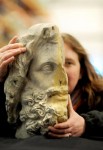 An 1,800-year-old marble bust of Jupiter was found in English Heritage’s main northern archaeological storage unit in Helmsley, North Yorkshire.
An 1,800-year-old marble bust of Jupiter was found in English Heritage’s main northern archaeological storage unit in Helmsley, North Yorkshire.
Conservators examined it and quickly realized it wasn’t a reproduction, but rather a genuine 2nd c. Roman sculpture that had been given to the Earl of Arundel, one of the first dedicated collectors of antiquities, by Dudley Carter in the early 17th century.
It was first documented in 1616, but the collection itself became dispersed later in the 17th Century.
However, about 100 years later, the bust fell into the hands of John Aislabie, an MP and wealthy owner of Fountains Abbey and Studley Royal, near Ripon.
It is believed it may then have taken pride of place in the Temple of Jupiter on the Studley Royal estate, adding a touch of authenticity to the 18th Century folly.
The Studley Royal neo-classical folly is actually called the Temple of Piety and was dedicated to Hercules, but it became known as the Temple of Jupiter because of the bust.
Aislabie found the bust in the cellar, where it had been relegated after the Earl of Arundel’s collection was broken up later in the 17th century. A lot of the Earl’s pieces were discarded rather unkindly, so it may have been at this point that the bust was damaged as we see it today.
 Aislabie loved it anyway, so he moved the sculpture to Studley Royal and built the temple with Jupiter as its centerpiece. Aislabie’s son remodeled the temple and removed the sculpture, eventually putting it in storage.
Aislabie loved it anyway, so he moved the sculpture to Studley Royal and built the temple with Jupiter as its centerpiece. Aislabie’s son remodeled the temple and removed the sculpture, eventually putting it in storage.
Nobody’s quite sure how it got from Studley Royal to the English Heritage storeroom, but Professor Michael Vickers of Oxford’s Ashmolean confirmed that it was indeed the Jupiter bust from Arundel’s collection. Experts have looked for it in collections before but obviously never found it.
The bust is in fairly good condition despite its missing half. It needs cleaning and further research to try to pin down its movements over the centuries. Conservators will analyze the marble to determine exactly which part of the Roman world it may have come from originally.
Other than that, it’s good to go. In fact it will become the centerpiece of a series of free tours of the Helmsley facility which is normally closed to the public. It looks really cool in there. Huge floor to ceiling racks of dusty marbles just waiting to be explored.